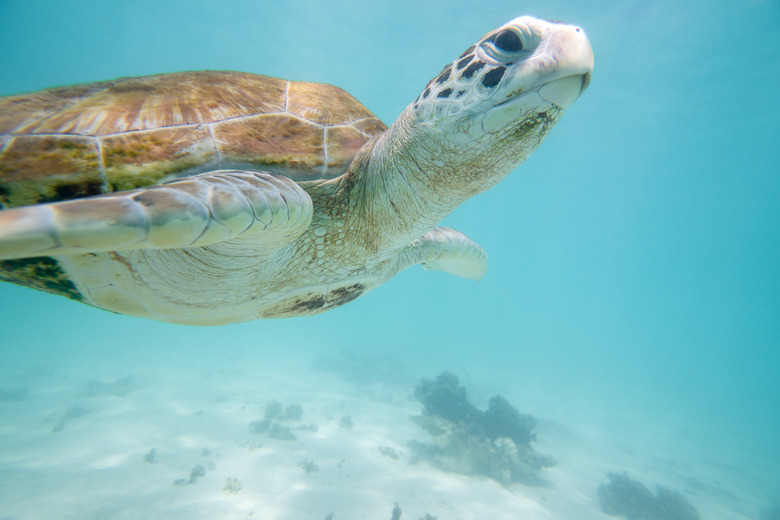Body Parts Of A Turtle
Turtles are thought to be one of the most ancient species, changing little since they appeared on earth millions of years ago. Turtles' highly specialized body parts and uses can seem anything but primitive, however, giving turtles abilities that can seem like something out of science fiction.
A protective covering
A protective covering
You might have heard that a turtle carries his house on his back. In reality, a turtle's shell isn't a "house" at all but part of the skeletal system. Unlike turtles in cartoons, a turtle can't pop out of his shell and live independently from it. Instead, his ribs and spinal column are fused to the carapace (the top curved part of the shell) and the plastron (the bottom plate).
Although superficial injuries to the shell can sometimes heal on their own, a pet turtle with a cracked or broken shell needs immediate veterinary care. The fracture allows bacteria to access to the internal organs beneath the shell, and the turtle will likely die if he doesn't receive antibiotics, shell repair, and long-term supportive care to help him thoroughly heal.
The turtle's shell consists of 50 to 60 bones as well as living tissue, blood vessels, nerves, and cartilage. Turtles with hard shells also have an outer layer of scutes made of keratin, a protective protein shield similar to a human's fingernails. However, the scutes absorb essential sunlight and will also absorb toxic chemicals, so never paint or use nail polish on your turtle.
Interacting with their world
Interacting with their world
A turtle's integumentary system is what stands between her and the outside world. The turtle's shell is just one part of this system. The free-moving parts of a turtle — legs, tail, and head — are covered in thick skin that is rich in keratin to stand up to long immersion in water. The skin helps turtles absorb heat from their environment to maintain the turtle body temperature suited for their low metabolism requirements.
The skin also has glands that let a turtle communicate through chemical signals. Some examples include scent glands near a turtle's cloaca that in some turtle species can make a distinct stink when they are frightened and mental glands on the head producing chemical signals essential to communicating with other turtles.
A turtle's eyes have lids that protect it from debris. A third eyelid known as the nictating membrane acts like goggles when the turtle dives under water, protecting her from injury while allowing her to see clearly. Just behind the eyes, the tympanic membrane lets the turtle hear, although turtles have poor hearing.
Breathing the air
Breathing the air
Unlike humans, a turtle's rib cage doesn't expand and contract to help him breathe; his ribs are immovably fused to his shell. Instead, a turtle has specialized muscles that allow the lungs to expand and contract. The turtle takes in oxygen through his nostrils, known as nares.
These specialized holes allow a turtle to breathe with his mouth closed, bringing the air into the inner nares and down the trachea into the lungs. Unlike frogs, which have simple sacs for lungs, turtles have aveoli — which are many little air sacs — in the lungs that maximize oxygen exchange.
They can also breathe through their butt. Their cloaca — the area beneath their tail used to excrete waste — is rich in blood vessels. Turtles hibernating in winter can fan water over the area where oxygen from the water gets absorbed by the blood vessels.
Maintaining turtle life
Maintaining turtle life
The turtle's internal organs function much like a human's. Food is taken in through the mouth and passed into the gullet. Turtles don't have teeth but a beak for gripping and tearing and keratin plates to help compress their food. The food passes through the digestive system, where nutrients are extracted. Like humans, turtles excrete both solid waste and liquid waste. They even pass gas.
The cloaca is where both solid and liquid waste get excreted. The versatile organ is also used for reproduction and laying eggs.
References
- IFL Science: Ever Wondered What's Inside A Turtle Shell? Come Take A Peek
- CBS DFW: Wildlife Group Shares Photos Of Turtle Covered In Nail Polish
- IntechOpen: Reptilian Skin and Its Special Histological Structures
- PubMed.gov: Evolutionary History of Mental Glands in Turtles Reveals a Single Origin in an Aquatic Ancestor and Recurrent Losses Independent of Macrohabitat
- Forest Preserve District Will County: Nature Curiosity — Why and How Do Turtles Breathe Through Their Butts?
- YouTube: Scherr Biology – Turtle Dissection
- Springfield Public Schools: Turtle Dissection Lab
- Australian Wildlife Rehabilitation Conference: Filling in the Cracks – Shell Fractures in Turtles
